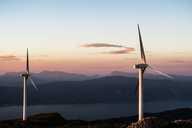{{ vm.autoCompleteLoadingText }}

Renewable energy generation such as solar and wind can help individuals and organisations combat climate change.
It's easy to find out if we work in your area, all we need is your postcode.

Are you ready to commission your single or multiple micro generation scheme? Find out more on our G98 page and use our online form to notify us of your installation.

Are you ready to apply for a fast track generation installation? Find out if your generation installation is eligible for this route and use our online form to apply.

Are you ready to commission your larger-scale generation installation? Find out more about standard G99 generation and the forms that you need to complete in order to apply.

If you would like to decommission your generation installation then you will need to complete a decommissioning form. Click the button to read more and get started.

Solar power works by converting energy from the sun into power. Electricity is generated through the use of solar panels, which range in size from residential rooftops to ‘solar farms’ stretching over acres of land.
Solar panels are usually made from silicon, or another semiconductor material, installed in a metal panel frame with a glass casing. When this material is exposed to photons of sunlight it releases electrons and produces an electric charge.
This PV charge creates an electric current (specifically, direct current or DC), which is captured by the wiring in solar panels. This DC electricity is then converted to alternating current (AC) by an inverter. AC is the type of electrical current used when you plug appliances into normal wall sockets.

Wind turbines can turn the power of wind into the electricity we all use to power our homes and businesses. They can be stand-alone, supplying one or a very small number of homes or businesses, or they can be clustered to form part of a wind farm.
Each of turbine consists of a set of blades, a box beside them called a nacelle and a shaft. The wind makes the blades spin creating kinetic energy. The blades rotating in this way then also make the shaft in the nacelle turn and a generator in the nacelle converts this kinetic energy into electrical energy.
To connect to the national grid, the electrical energy is then passed through a transformer on the site that increases the voltage to that used by the national electricity system.

You don't need to install a battery or storage for your solar or wind generation to work, but a battery can help you to fully benefit from the energy that your installation generates.
Having a battery or storage installed means you can use any additional energy that is stored when your generation device(s) aren't running e.g. at night-time for rooftop solar.

The DCODE (The Distribution Code of Licenced Distribution Network Operators of Great Britain) website hosts DG Connection Guides available for download.

A Customer Export Limitation Scheme (ELS) may be suitable for customers seeking to increase their installed generation or demand, and who want to restrict the net export or import of their connection, rather than wait for or contribute to the reinforcement cost.

We use essential cookies to make our website work and provide you with a good experience. Full details can be found in our cookie policy . We'd like to set additional cookies to understand how you use our website and remember your settings.